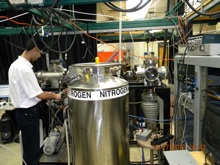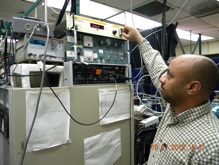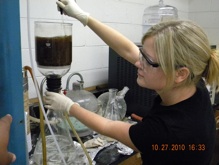






Molecular Clusters, Gas Phase and Cluster Polymerization
Molecular beam techniques are applied to synthesize different classes of weakly bound molecular clusters and metal atom-doped molecular clusters. Resonant two-photon ionization coupled with time-of-flight mass spectrometry is then applied to study the spectroscopy of size specific clusters. We are interested in measuring the size-dependent spectroscopic lineshifts and lineshapes of a particular atomic or molecular excitation in these clusters.
The study of gas phase and cluster polymerization is an important intellectual and technological frontier which promises unique results not only for a fundamental understanding of polymerization reactions, but also for the development of new materials with unique properties. Using cluster beam techniques we have demonstrated, for the first time, that sequential polymerization reactions can occur on a time scale of a few microseconds following the ionization of the neutral clusters. Our current studies involve photodissociation of mass-selected ions in order to characterize the structures of the polymeric ions, and hence, measure the extent of the propagation reaction. The conversion of vdw clusters into size-specific covalent-bonded polymeric species will lead to the design of novel engineered materials with tailored unique properties.
This research in our laboratory has lead to the discovery of a novel technique for polymerization using metal ions generated in the gas phase by laser vaporization techniques [C&E News, May 24, 1993]. Using this method, high molecular weight polymers (106 units, polyisobutylene) have been synthesized. The polymeric materials also contain submicron-sized metal particles. With this method, it is now possible to incorporate essentially any ultrafine metal particles in essentially any polymer that can be made by cationic polymerization. The extra flexibility introduced by applying an electric field to modulate the polymer morphology makes these composites interesting candidates to explore new conducting, superconducting or magnetic materials. Manufacturing polymers with these properties could enhance the overall electro-optic performance and the efficient use of available materials.
Vapor Phase Homogeneous and Ion Induced Nucleation
Nucleation is one of the most ubiquitous and important phenomena in science and technology. It plays a central role in materials science, crystal growth, chemical processing, atmospheric science and cosmochemistry. This research area is of increasing importance to atmospheric chemistry, polar stratospheric clouds, acid rain and air pollution.
We have reported the first study of the homogeneous nucleation of highly polar liquids This study has demonstrated the failure of the classical nucleation theory and introduced new models for dipole alignments in clusters.
We are currently developing a new technique for the study of nucleation on well-defined ions. The method is based on Resonance Enhanced Multiphoton Ionization (REMPI), in which well-defined molecular ions act as nucleation centers for the condensation of supersaturated vapors. These experiments allow, for the first time, to selectively and unambiguously generate specific ions of interest and study their nucleating behaviors during the condensation of supersaturated vapors. We are developing this method as an ultra sensitive amplifier and detector for the chemical analysis of aerosol particles.
Nanostructured Materials
Recently, we have developed a new method for generating nanoscale metal oxide, nitride or carbide particles down to 5 nm size by laser vaporization of metal targets followed by gas phase reactions and deposition onto cold surfaces in a diffusion cloud chamber. Particle size is readily controlled by the degree of supersaturation, which is controlled through the temperature gradient, pressure and laser power. The composition is controlled by the choice of the solid target and the gas mixture.
Using this method, we have discovered a new form of silica nanoparticles that aggregate into a novel weblike microstructure with ultra high porosity and a very large surface area (500 m^2/g) and exhibit bright blue photoluminescence [C&E News, January 15, 1996]. This material can provide new applications in optical devices, catalyst support and as a polymer reinforcing agent.






